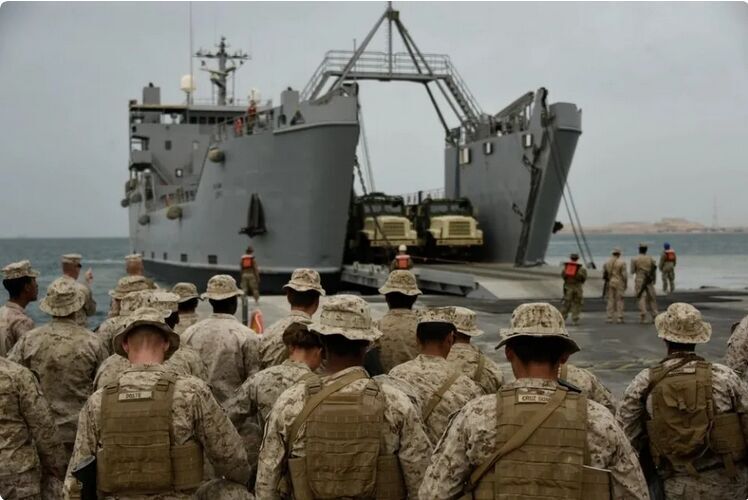
© US Army photo by Spc. Travis TeateLogistics support vessel USAV SP4 James A. Loux prepares to unload vehicles onto the trident pier and be driven by the US Marines located in the United Arab Emirates.
The troops are training to fight across the challenging landscape after 20 years of fighting on land in the Middle East, according to The Washington Post.
A US Navy admiral recently described to the US Armed Services House Committee the growing threat from China
US Navy Adm. John Aquilino. said its military build-up was on a 'scale not seen since WWII' and Beijing was on track to be able to invade Taiwan by 2027.
Comment: With all the these references of WWII, one gets the impression they're trying to tell us something: US admiral says Red Sea is largest battle Navy fought since World War II
The military is creating new Marine units, such as the 3rd Marine Littoral Regiment, which are designed to be smaller and more agile and would work to support a larger joint force.
These smaller, more mobile units would gather intelligence and share it rapidly rather than carrying out traditional amphibious assaults.
They would also be able to conduct precision strikes when necessary, such as sinking ships with medium-range missiles, per the Post.
"We've spent most of the last 20 years looking at a terrorist adversary that wasn't exquisitely armed, that didn't have access to the full breadth of national power," Col. John Lehane, the 3rd Marine Littoral Regiment's commander, told the Post.
"And now we've got to reorient our formations onto someone that might have that capability."
Lehane said that the unit's most valuable role would be the ability to "see things in the battlespace, get targeting data, make sense out of what is going on when maybe other people can't."
Pentagon experts expect that US satellites will be jammed or destroyed by China in the event of a potential war, the Post noted.
The new Marine forces are envisioned to play a critical role in enabling larger joint operations aimed at countering Chinese aggression in the region towards countries like Taiwan, Japan, and the Philippines.
Comment: China is countering US belligerence in the region: US to deploy 5 aircraft carriers in western Pacific in latest provocation against China
In particular, Taiwan has long feared a potential invasion by China.
It was reported this week, that China has built a mock-up of a key area of Taiwan's capital city where the presidential office and other government buildings in the desert area of Inner Mongolia.
China has also been documented building mock-ups of US aircraft carriers and other warships at training sites, likely to test and improve its missiles.
China has home-field advantage
China has for decades pressured governments not to recognize Taiwan as a sovereign nation and has promised to "unify" the self-governed island with the mainland by 2050.
Comment: And until recently the US recognised Taiwan as part of China.
Beijing has greatly expanded its reach in the Pacific in recent years, such as by building artificial islands for military outposts in the South China Sea and looking to expand bases in the Indian and Pacific oceans, the Post noted.
Comment: So has the US: US army stations special forces 'permanently' near mainland China's coast, begins training Taiwan's troops
Not only does China have the largest military forces in the region, but it would also have a home-field advantage and could more easily deploy its roughly one million troops, ships, and aircraft to any battle.
By comparison, the US' ships and planes would need to travel thousands of miles or rely on partner nations allowing them to station men and weapons on their territory.
The US Marine Corps new plan is known as Force Design, and will focus on putting Marines on the front lines while keeping them hidden from radar and other detection methods.
These "stand-in" groups, which could comprise thousands in an area, would be used to support larger joint forces in confronting major adversaries.
Analysts say that the new Marines strategy is promising, but will face challenges such as logistical hurdles in such a large maritime region.
It is also uncertain whether regional partners like Japan would allow US forces to fight from their territory, as some officials might fear angering Beijing and being drawn into a conflict between them and the US, the Post said.
In 2021, The Washington-based think tank, the Center for Strategic and International Studies, conducted war games to imagine how a war between China and the US over Taiwan would play out.
In one of the more pessimistic scenarios, 900 American fighter and attack aircraft would be lost in four weeks, equivalent to half of the US Air Force and Navy's combat planes.
However, the losses on both sides would be epic.
Mark Cancian, a senior advisor at the Center for Strategic and International Studies, told Business Insider that the war-gaming showed: "The United States and Taiwan are generally successful in keeping the island out of Chinese occupation, but the price of that is very high — losses of hundreds of aircraft, aircraft carriers, and terrible devastation to the Taiwanese economy and also to the Chinese navy and air force."
Source link

